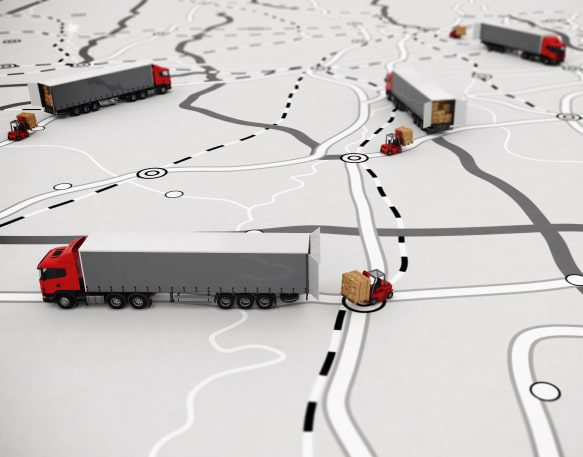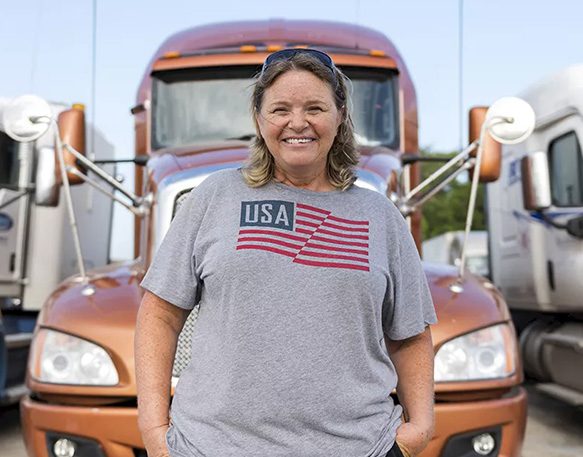Whether you’re a carrier or an owner-operator, it takes a great deal of planning and strategizing to make the most of your trucking business and maximize your profits. One of the primary ways that you can boost your profits is by having a plan in place for how you’ll handle backhauls.
Understanding the difference between headhaul vs backhaul shipping is incredibly valuable for carriers and owner-operators. After all, the rate for a load is not just dependent on factors like distance or what’s being shipped–whether a load is backhaul vs headhaul can also influence the rate you are offered, making it more or less worthwhile.
The most successful truckers can manage both types of loads and use them together to improve their business. Let’s take a closer look at what each type of load is, what the main differences between headhaul vs backhaul shipping, and how you can take advantage of each type to boost your rates and keep on trucking.
What is headhaul?
In simplest terms, a headhaul is the load that takes a truck to its destination, from point A to point B. When it comes to truckload rates, the headhaul is the highest-paying portion of a roundtrip. For example, a dry van load going from Los Angeles to Denver typically pays a much higher rate than loads going from Denver to Los Angeles. That’s because of the supply and demand for trucks in each market. In this example, L.A. to Denver would be considered a headhaul rate.
As a result, carriers and owner-operators will make the bulk of their revenue off of headhauls. In addition, while truckers typically want to avoid deadhead miles as much as possible, sometimes they may find it worthwhile to deadhead into areas with a headhaul market if the rates are high enough to make a profit even with the deadhead miles.
What is backhaul?
While headhaul loads are taken from point A to point B, backhauls are the reverse. As the name suggests, backhauls are loads that are delivered on the return trip, from point B back to point A (or to a location near where carriers started their journey).
Going back to the previous example, loads hauled from Denver to Los Angeles typically pay backhaul rates, meaning that the rates are lower than on the L.A. to Denver lane.
Backhaul loads allow carriers to avoid deadhead miles, though they usually aren’t highly profitable. That’s why it’s important to consider the entire roundtrip when choosing a headhaul load and negotiating rates. Hauling a load into a market where it will be difficult to find a backhaul load will result in higher operating costs if you’re forced to deadhead to find your next load.
Backhaul vs headhaul: What’s the difference?
Headhaul and backhaul loads are fundamentally two very different types of loads that carriers and owner-operators can take on, but a mix of both is the key to finding success. A look into some of the differences between the two make it clear why.
The main differences between these two types of loads ultimately come down to supply and demand.
With headhaul loads, demand from shippers typically outweighs the supply of carriers and trucks available to deliver those loads. This is favorable for carriers, as it means that they will likely have plenty of loads to pick from right from whatever location they are starting out in. It also means that rates are more likely to be higher for headhauls, meaning that carriers can make much of their revenue from them.
On the other hand, backhaul loads are typically defined by lighter demand since there may be fewer shipments going in the opposite direction while the number of available drivers and vehicles remains the same. That means the backhaul loads will be offered at a lower rate and carriers will have fewer loads to choose from.
Another main difference between headhaul vs backhaul loads is location. Certain markets are known for having more inbound freight volume than outbound. For instance, Florida and Las Vegas are two areas that have high levels of inbound traffic with relatively little outbound freight. This means that they might be good headhaul destinations, but you may struggle to find a good backhaul load to take with you. As a result, you may end up deadheading for some, if not all, of your return trip.
What are deadhead miles?
After delivering a headhaul load, carriers and owner-operators typically have two options: to take backhaul with them on the return trip, or to deadhead back home. Deadheading is whenever you make a trip without any cargo in your truck trailer.
Deadhead miles occur in two instances. The first is when carriers have to drive to pick up their headhaul load from its origin point. Say that a trucker is currently in Savannah, GA and sees a load available to pick up in Atlanta, GA. The distance they drive from Savannah to Atlanta would be considered deadhead.
The second instance is when you don’t have any loads to haul for a return trip from a headhaul delivery. Since finding a backhaul is often harder than finding a headhaul, there are times when carriers and owner-operators may be unable to find a load going out of their location. In this scenario, truckers will have no choice but to deadhead for at least part of their journey until they reach a market with loads going back to their origin. For example, if a trucker’s headhaul is from Atlanta to Miami and there are no loads going in the opposite direction, they may need to deadhead to Jacksonville to get a load headed to Atlanta.
Deadheading is something of a worst-case scenario for carriers. Moving an empty trailer means that your business is actively losing money. For each mile you spend on the road with nothing to haul, the more you’ll sink into costs like fuel and maintenance without making any money to offset them. The time lost by deadheading also means that profit margins will shrink.
In addition to the financial obstacles that deadhead miles present to carriers, deadheading can also be dangerous. An empty truck trailer weighs much less than a filled one, which means that vehicles are less anchored to the road. If drivers are inexperienced, or if they’re driving through poor weather conditions with slippery roads or high winds, this drastic change in weight can lead to vehicle damage, accidents, and other problems on the road.
How can drivers avoid deadhead miles?
The good news is that deadheading isn’t inevitable. Truck drivers can take action to minimize or completely avoid deadhead miles. Planning ahead is one of the most important things you can do to minimize deadheading. Map out your trips in advance and try to ensure that you always have a return load set up.
It’s also a good idea to use modern technology like a transportation management system (TMS). Not only can a TMS help you plan more efficient routes, but it can also provide up-to-date market rates so you can determine fair and competitive rates and offer real-time visibility into the transportation process.
You can also use route optimization software and predictive analytics to get a better understanding of the average flow of goods, as well as going rates, in an area.
Something like a high-quality load board can also help you find loads quickly. You can discover loads originating from your current (or future) location and carefully plan a route that minimizes deadhead miles.
How do headhauling and backhauling benefit my trucking business?
When it comes to trucking, having a backhaul strategy is important because it improves your fleet operations. Keeping your truck loaded as frequently as possible will translate into maximized revenue and increased efficiency. Planning ahead to gain visibility on the next two or three loads you’ll be taking will help you sort out your backhauls and make the actual journey much more seamless since you won’t be scrambling to find freight once already at your headhaul destination. It also means you’ll be able to minimize your deadhead miles.
But to make the most of these benefits, carriers and owner-operators should ensure that they are taking the right backhaul loads for their business, not just any backhaul load. To do this, it’s important to have a good understanding of your finances before picking up a load. Keeping track of your operating costs and finding ways to trim your expenses can help you determine which backhaul loads are worth it for you. Main costs include:
- Fuel: This is the biggest expense for owner-operators, and represents about 38% of total operating costs. Learn more about how to manage fuel costs here.
- Leased vehicle/equipment costs
- Insurance/permits/tolls
- Repairs and maintenance
DAT estimates that the average operating cost for owner-operators is around $2.01/mile. By understanding how much your costs are, you’ll be able to discern whether or not a particular headhaul or backhaul load will be a net positive or negative for your business.
The power of strategic headhaul and backhaul planning
Whether you’re just starting out in the trucking industry or already have lots of experience under your belt, having a strong understanding of headhaul vs backhaul shipping as well as strategies to reduce deadhead miles can make a huge difference. By strategically planning routes and understanding market dynamics, you can not only increase your operational efficiency but also raise your revenue.
Backhaul loads may generally pay less than headhauls, but they’re unavoidable. However, by carefully planning your backhaul loads and routes, you can minimize deadhead miles. Using modern technology like transportation management systems, load boards, and route optimization software can help you combine backhaul and headhaul loads in a balanced and profitable way.
Find the best loads with DAT!
The DAT load board is the best place to find both headhaul and backhaul loads that help keep your vehicle full to avoid dreaded deadheading. With more than 644,500 new posts every day, there are always great freight opportunities available on the DAT load board. Sign up today to experience the largest freight marketplace in the industry for yourself.




